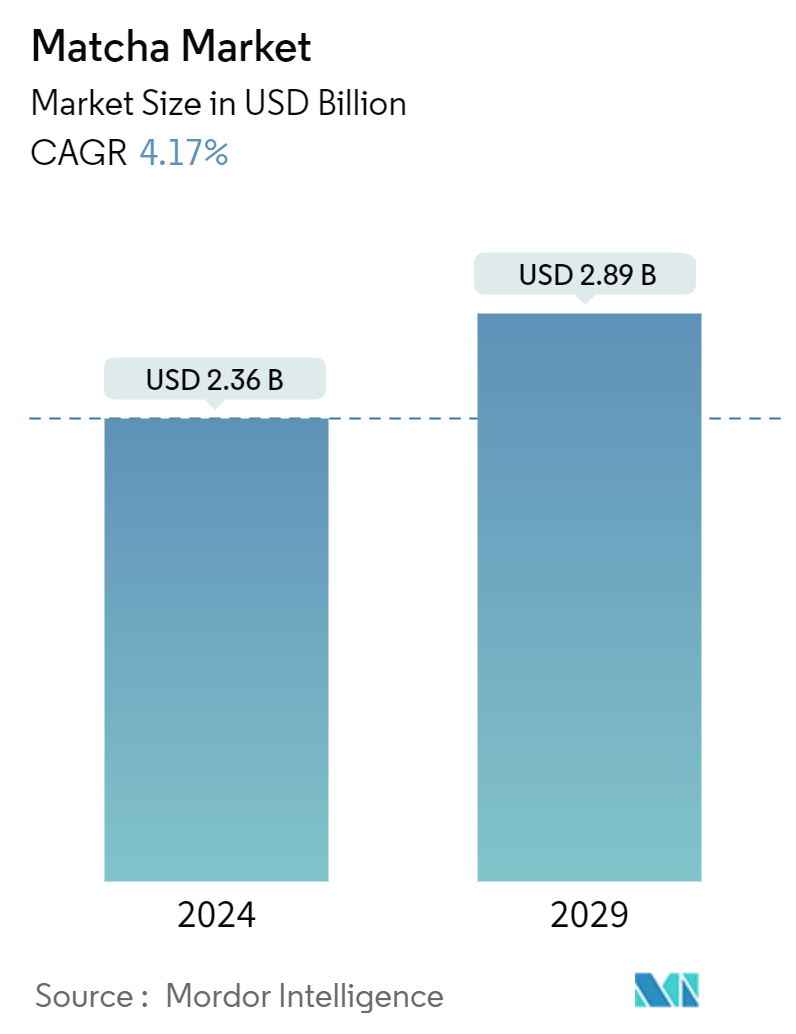Market Size of Matcha Industry

| Study Period | 2019- 2029 |
| Market Size (2024) | USD 2.36 Billion |
| Market Size (2029) | USD 2.89 Billion |
| CAGR (2024 - 2029) | 4.17 % |
| Fastest Growing Market | South America |
| Largest Market | Asia Pacific |
Major Players.webp)
*Disclaimer: Major Players sorted in no particular order |
Matcha Market Analysis
The Matcha Market size is estimated at USD 2.36 billion in 2024, and is expected to reach USD 2.89 billion by 2029, growing at a CAGR of 4.17% during the forecast period (2024-2029).
Matcha contains a high concentration of antioxidants and is often associated with health benefits on metabolism and cognitive function. Thus, the rising awareness of the health benefits associated with consuming matcha and the increasing consciousness among consumers about the negative health impact of carbonated drinks are significant factors driving the market. Furthermore, consumers are becoming more discerning about the quality of matcha. The trend toward premium-grade matcha, with consumers willing to pay a higher price for superior quality and authenticity, encourages manufacturers to launch premium products. For instance, in December 2022, MatchaKo unveiled its first ready-to-drink premium matcha drink in the United States market. Per the brand’s claim, matcha drink was certified organic, non-GMO project verified, and vegan. Besides this, the versatility of matcha in different applications, such as snacks, desserts, smoothies, and beauty products, is anticipated to provide a positive outlook for the market during the study period.
Matcha Industry Segmentation
Matcha is a unique, powerful form of green tea grown in the shadow for three to four weeks before harvest. The global matcha market is segmented by product, form, distribution channel, and geography. By product, the market is segmented into regular tea and flavored tea. By state, the market is segmented into powder and liquid forms. By distribution channel, the market is segmented into hypermarkets/supermarkets, specialty stores, online retail stores, and others. By geography, this report includes an analysis of regions like North America, Europe, Asia-Pacific, South America, and the Middle East and Africa). For each segment, the market sizing and forecasts have been done based on value (in USD).
| Product Type | |
| Regular | |
| Flavored |
| Form | |
| Powder | |
| Liquid |
| Distribution Channel | |
| Hypermarket/Supermarket | |
| Speciality Stores | |
| Online Retail Stores | |
| Others |
| Geography | |||||||||
| |||||||||
| |||||||||
| |||||||||
| |||||||||
|
Matcha Market Size Summary
The matcha market is experiencing a notable expansion, driven by increasing consumer awareness of its health benefits, particularly its high antioxidant content and positive effects on metabolism and cognitive function. This growing consciousness is steering consumers away from carbonated drinks towards healthier alternatives like matcha. The market is also witnessing a shift towards premium-grade matcha, with consumers willing to invest in higher quality and authenticity. This trend is encouraging manufacturers to introduce premium products, such as ready-to-drink matcha beverages. The versatility of matcha, being used in snacks, desserts, smoothies, and beauty products, further enhances its market appeal. The rising focus on balanced diets and natural food choices is propelling matcha as a preferred option for those seeking nutritious alternatives, especially in the context of preventing chronic degenerative diseases.
In the Asia-Pacific region, India stands out as a significant market for matcha, with increasing consumer interest in green tea and its health benefits. This has prompted brands to expand their offerings in the country, introducing various green tea flavors and products. The cultural significance of matcha in Japan, coupled with its global popularity, is driving demand both domestically and internationally, boosting production and export activities. The competitive landscape of the global matcha market features several regional and international players, with companies like AIYA America Inc., PepsiCo Inc., and Breakaway Matcha LLC leading the charge. These companies are innovating to meet evolving consumer needs and maintain their market positions. Recent strategic moves, such as Aiya Matcha's acquisition of OMGTea and Ippodo Tea's launch of a premium matcha blend, highlight the dynamic nature of the market.
Matcha Market Size - Table of Contents
-
1. MARKET DYNAMICS
-
1.1 Market Drivers
-
1.1.1 Increasing Focus On Health and Wellness
-
1.1.2 Surge in Product Innovation
-
-
1.2 Market Restraints
-
1.2.1 Presence of Substitutes
-
-
1.3 Porter's Five Forces Analysis
-
1.3.1 Bargaining Power of Suppliers
-
1.3.2 Bargaining Power of Buyers
-
1.3.3 Threat of New Entrants
-
1.3.4 Threat of Substitute Products and Services
-
1.3.5 Degree of Competition
-
-
-
2. MARKET SEGMENTATION
-
2.1 Product Type
-
2.1.1 Regular
-
2.1.2 Flavored
-
-
2.2 Form
-
2.2.1 Powder
-
2.2.2 Liquid
-
-
2.3 Distribution Channel
-
2.3.1 Hypermarket/Supermarket
-
2.3.2 Speciality Stores
-
2.3.3 Online Retail Stores
-
2.3.4 Others
-
-
2.4 Geography
-
2.4.1 North America
-
2.4.1.1 United States
-
2.4.1.2 Canada
-
2.4.1.3 Mexico
-
2.4.1.4 Rest of North America
-
-
2.4.2 Europe
-
2.4.2.1 United Kingdom
-
2.4.2.2 Germany
-
2.4.2.3 Spain
-
2.4.2.4 France
-
2.4.2.5 Italy
-
2.4.2.6 Russia
-
2.4.2.7 Rest of Europe
-
-
2.4.3 Asia-Pacific
-
2.4.3.1 China
-
2.4.3.2 Japan
-
2.4.3.3 India
-
2.4.3.4 Australia
-
2.4.3.5 Rest of Asia-Pacific
-
-
2.4.4 South America
-
2.4.4.1 Brazil
-
2.4.4.2 Argentina
-
2.4.4.3 Rest of South America
-
-
2.4.5 Middle East & Africa
-
2.4.5.1 United Arab Emirates
-
2.4.5.2 South Africa
-
2.4.5.3 Rest of Middle East & Africa
-
-
-
Matcha Market Size FAQs
How big is the Matcha Market?
The Matcha Market size is expected to reach USD 2.36 billion in 2024 and grow at a CAGR of 4.17% to reach USD 2.89 billion by 2029.
What is the current Matcha Market size?
In 2024, the Matcha Market size is expected to reach USD 2.36 billion.

